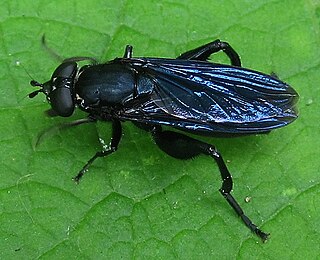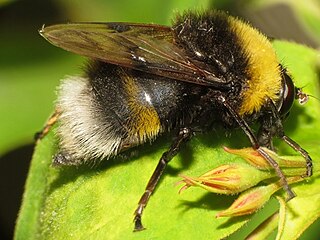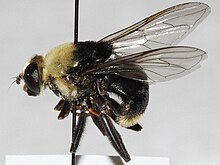
Blera is primarily a North American genus, though there are 3 species from Europe. The genus is characterized by the following characters:

Chalcosyrphus is a genus of hoverflies in the subfamily Eristalinae. Many species exhibit some degree of mimicry of various sawflies and other hymenopterans and are often brightly coloured or metallic in hue. The adults are similar in structure and behavior to the related genus Xylota but differ in larval morphology. They can be found throughout Europe, Asia, and North America and seem to prefer damper, boggy habitats. The larvae are saproxylic feeders in rotten wood in these habitats.

Pocota is a genus hoverflies, from the family Syrphidae, in the order Diptera.

Tropidia is a genus hoverflies, from the family Syrphidae, in the order Diptera.
Neoascia metallica, the Double-banded Fen Fly, is a common species of syrphid fly observed across North America. Hoverflies can remain nearly motionless in flight. The adults are also known as flower flies, for they are commonly found on flowers, from which they get both energy-giving nectar and protein-rich pollen. The larvae are aquatic.

Chalcosyrphus (Xylotomima) inarmatus, the Yellow-haired Leafwalker, is an uncommon species of syrphid fly found across northern North America. Hoverflies are able to remain nearly motionless in flight. The adults are also known as flower flies for they are commonly found around and on flowers, from which they get both energy-giving nectar and protein-rich pollen.

Hadromyia pulchra is a species of hoverfly in the family Syrphidae.

Sphecomyia is a genus of hoverfly in the family Syrphidae. There are about 16 described species in Sphecomyia.
Sphecomyia pattonii is a species of syrphid fly in the family Syrphidae.

Chalcosyrphus (Xylotomima) metallifer , the Orange-horned Leafwalker, is a rare species of syrphid fly observed in the Eastern United States. Hoverflies can remain nearly motionless in flight. The adults are also known as flower flies for they are commonly found on flowers, from which they get both energy-giving nectar and protein-rich pollen.

Chalcosyrphus (Xylotomima) piger, the short-haired leafwalker, is an uncommon species of syrphid fly found throughout North America and Europe. Hoverflies get their names from the ability to remain nearly motionless while in flight. The adults are also known as flower flies, for they are commonly found around and on flowers, from which they get both energy-giving nectar and protein-rich pollen. Larvae have been identified from sappy hollows from Larix and Pinus.

Criorhina caudata is a species of hoverfly in the family Syrphidae.

Milesia virginiensis, known generally as the yellowjacket hover fly or Virginia flower fly, is a species of hoverfly in the family Syrphidae.
Tropidia coloradensis is a species of hoverfly in the family Syrphidae.
Chalcosyrphus satanicus is a species of hoverfly in the family Syrphidae.
Xylota caerulifrons is a species of hoverfly in the family Syrphidae.
Xylota flavitibia is a species of hoverfly in the family Syrphidae.
Xylota tuberculata is a species of hoverfly in the family Syrphidae.
Neoascia distincta is a species of Hoverfly in the family Syrphidae.
Sphegina albipes is a species of hoverfly in the family Syrphidae.











